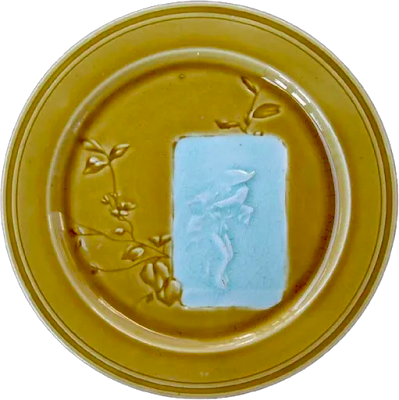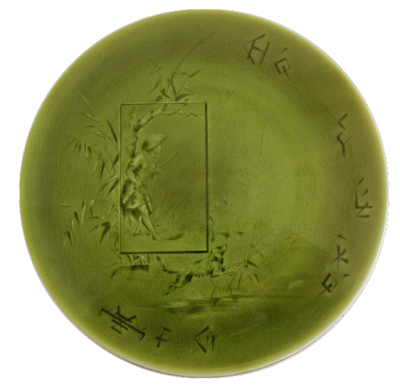The Exposition Universalle in Paris in 1878 is one of those benchmarks in art historical terms that had far reaching influence long after the show had closed. All of the finest manufacturers across the globe wanted their work showcased at the show. Choisy-le-Roi (CLR) was an active participant creating a gate to the Palace of Fine Art for the show. What ultimately stole the show however, was the display of Japanese decorative art shown for the first time outside Japan in a Western exposition. With Paris the center of art and culture in the last half of the Nineteenth century, the Japanese art had an enormous influence on Western decorative arts of the entire period. Western audiences were enthralled by the exotic imagery and geometric forms. Every facet of decorative art from Van Gogh paintings to wallpaper felt this influence. As the movement swept through Great Britain and then the United States it developed into an art historical period known today as the Aesthetic Movement.
The plate copied by the Etruscan Works is one from a series of majolica plates created in the Japanese style from this period. The series utilizes the intaglio Email Ombrant technique. Each of these plates feature a different geometric vignette. Each vignette encloses an active Asian figure balanced off center against some sort of free form Asian decorative motif which usually completes the scene. The figures are derived from various sources including Hokusai's Manga, a book of sketches made of life in Japan in the 17th Century.
The plates were glazed in either one solid color glaze--usually an olive green, turquoise, brown or ochre–--or two, like the Etruscan copy.
There is also a different series. This second series is considerably less common than the previous one. Unlike the other design, this one has no formal border around the central image but it also utilizes the Email Ombrant technique and the vignettes of the previous one. These all have one figure engaged in some athletic pursuit inside a vignette within a larger, more complex scene. Around the perimeter of the plate, there are various exotic looking figures meant to represent Japanese script. How authentic these are I can't say because I don't read Japanese, but they look more decorative than anything and certainly add an exotic Asian flavor to the overall design.
I have only seen these plates glazed in a monochromatic manner, in the same colors of the other series. I do not know how many different designs were created for this series as they rarely show up, but I would guess that there are probably twelve different designs for this group as well.
Both of these series' have a restrained sophistication so common of French majolica done in the intaglio manner and would make a striking, and unusual conversation starter at any meal.
Like most plates of this type, they remain quite reasonably priced with monochromatic examples beginning at about $30 a piece and two color plates beginning around $75, so they are well within the reach of most collectors.
So the next time you see them pick them up, and impress your friends with your art history background and continental sophistication!



































Very informative. I was researching one of the Japanesque plates prior to offering it for sale but, having read your article, I think I'll be hanging on to it now!
ReplyDeleteMany thanks and kind regards,
Chris
Have a cake stand like the 8th plate but the person and the diamond shape are the light blue ish green colour. Very nice.
ReplyDelete